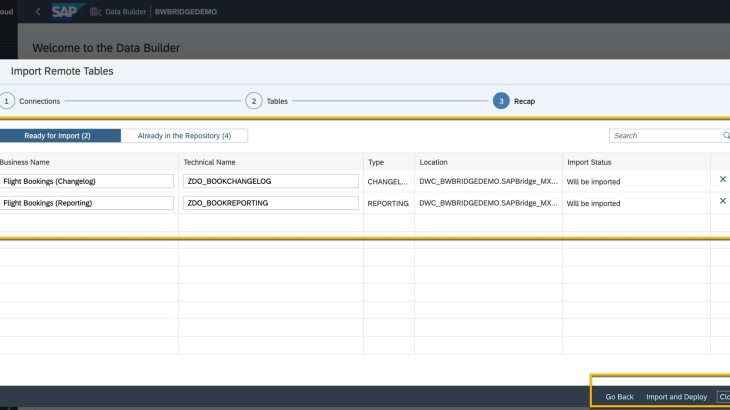Abstract
This blog post is about a strategic feature of SAP Data Warehouse Cloud, namely the SAP Data Warehouse Cloud, SAP BW bridge. SAP offers its customers through RISE with SAP, the opportunity to move with a business transformation as a service (BTaaS) to the cloud. For BW customers, this means SAP BW to SAP Data Warehouse Cloud. SAP positions SAP Data Warehouse Cloud as the strategic target solution for Data Warehousing in the public cloud, with SAP BW/4HANA Private Cloud Edition (PCE) as an option to start the transition. In this context, SAP BW bridge offers customers the opportunity to implement their new data warehousing use cases directly in the cloud environment while protecting, and retaining their existing on-premises investments. The blog provides an overview about SAP BW bridge, explains how to move from an existing SAP BW system to the cloud, and gives insights with a complete end-to-end greenfield scenario including a system demo in SAP Data Warehouse Cloud.
Overview
SAP Data Warehouse Cloud is SAP’s offering for all data warehousing use cases. This SaaS (Software-as-a-Service) is based on SAP HANA Cloud. It combines data, and analytics in a cloud solution that offers data integration, database, data warehouse, and analytics services. This enables customers to realize the full potential of a data-driven business. As a way to improve the integration with SAP ERP systems, the SAP BW bridge enables ABAP-based data extraction and staging capabilities within SAP Data Warehouse Cloud (see figure 1).
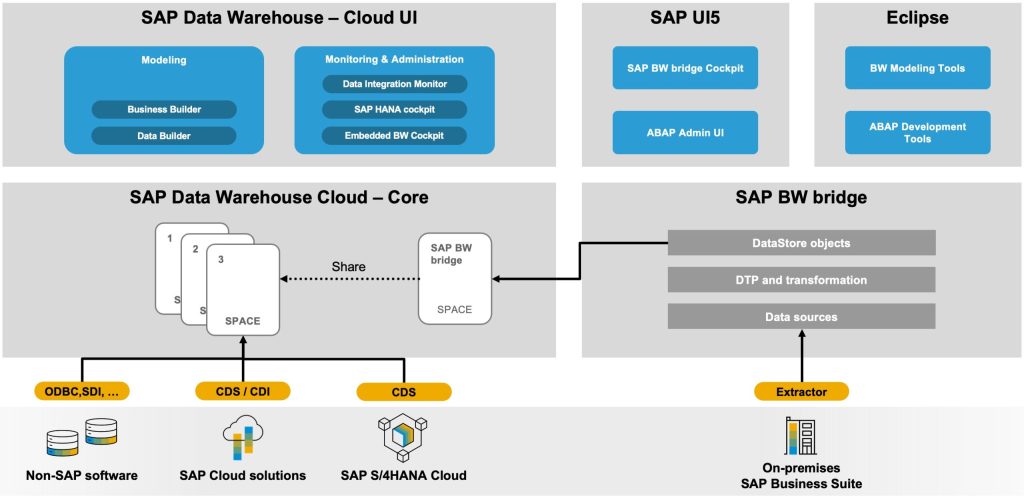
In the future, a tool-based transfer of existing SAP BW and SAP BW/4HANA staging scenarios will be enabled. Then the SAP BW bridge will enable a seamless transfer of existing ETL processes in a dedicated SAP BW bridge Space in SAP Data Warehouse Cloud. Here, the extensive functions of ODP extractors, and ABAP code within the SAP Business Technology Platform (SAP BTP) ABAP environment can be adopted in SAP Data Warehouse Cloud using the Cross-Space-Sharing approach.
SAP BW to SAP Data Warehouse Cloud
Within SAP BW bridge, customers are able to implement data extraction and staging scenarios up to the CompositeProvider level. In other words, it is not possible to create new queries within the SAP BW bridge environment. In this regard, within the SAP BW bridge, there is no support for OLAP engine, and functionality dependent on OLAP (e.g., analysis authorizations, query as info provider, query execution). Front-End tools do not have the possibility to access SAP BW bridge artefacts directly.
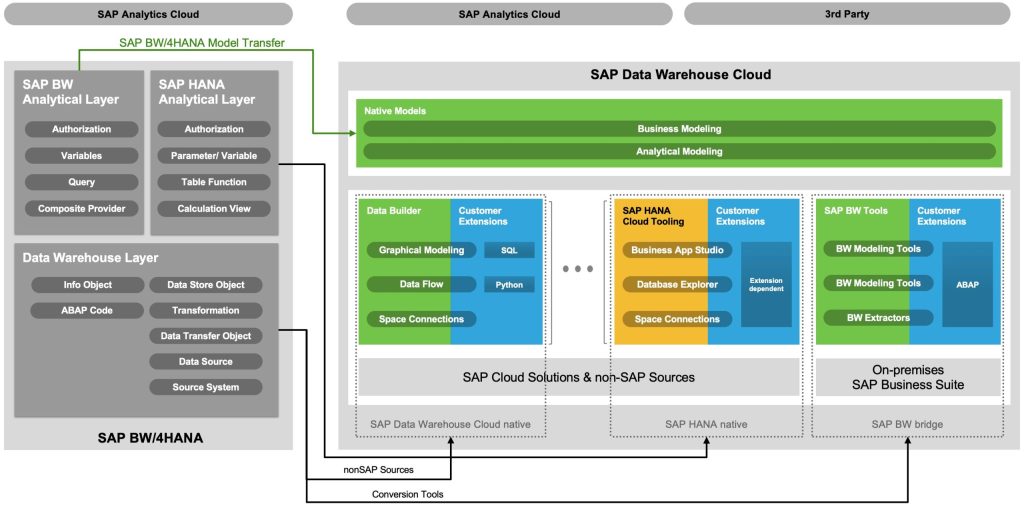
The SAP BW bridge environment is primarily intended for ODP-based source systems, which means that the connection scenarios only become available via Operational Data Provisioning (ODP). Non-SAP sources will be connected directly to SAP Data Warehouse Cloud (see figure 2). Objects from source SAP BW system(s) will be converted to the SAP BW bridge environment using Conversion Tools, including the SAP BW queries.
To take the full advantage of SAP’s data warehousing offerings, customers today need to deploy both SAP BW/4HANA, and SAP Data Warehouse Cloud. In the future, the SAP BW bridge will enable customers to merge these offerings into a single data warehouse solution in the cloud. With SAP BW bridge, SAP addresses BW customers that are looking for a way forward from SAP BW NetWeaver, and SAP BW/4HANA (See figure 3).
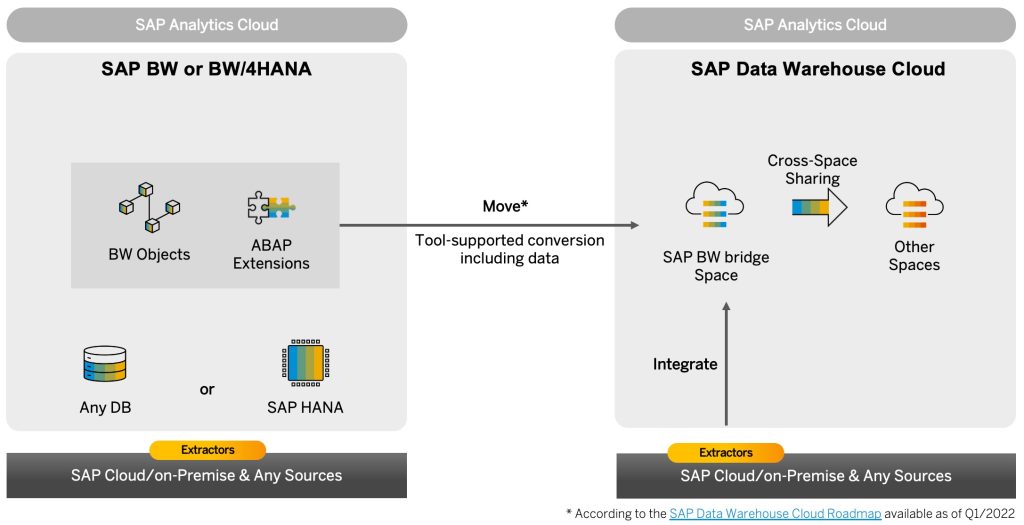
SAP BW Customers will have the option in 2022 to convert their existing on-premises investments to the cloud via remote, and shell conversion. First, the SAP BW bridge conversion will be offered for SAP BW 7.4, and SAP BW 7.5 systems (initially as shell conversion, followed as remote conversion), subsequently the conversion for SAP BW 7.3 systems (shell and remote conversion) will be available. Additionally, the conversion will be available for SAP BW/4HANA 2021 (shell and remote conversion). Regarding release coverage, please consider the details in the roadmap. Customers with lower SAP BW releases will need to upgrade their system(s) first, and then convert the required scope to SAP BW bridge in SAP Data Warehouse Cloud. Please note that SAP BW systems 7.40, and lower are already out of maintenance (see figure 4).
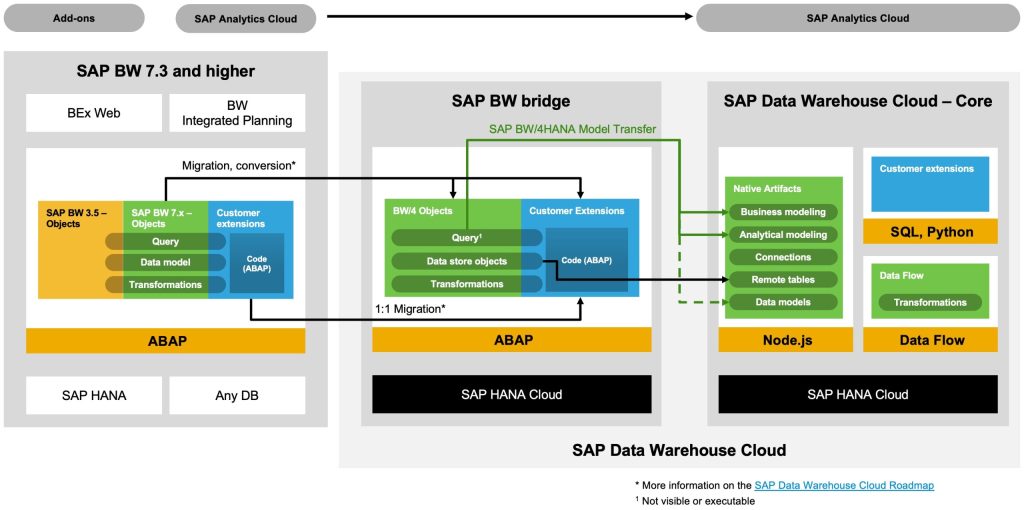
The SAP BW bridge artefacts out of the Business Technology Platform (SAP BTP) ABAP environment are available via remote tables using SAP HANA Cloud Smart-Data-Access (SDA) in a dedicated SAP BW bridge Space in SAP Data Warehouse Cloud. The remote tables in the SAP BW bridge Space can then be used in the regular SAP Data Warehouse Cloud Spaces via the SAP Data Warehouse Cloud cross-space sharing approach.
Add-ons are not supported in SAP BW bridge. Therefore, planning is not available within SAP BW bridge. In this regard, SAP positions SAP Analytics Cloud Planning as the planning application, and in the future (earliest end of 2022) SAP Data Warehouse Cloud as the planning foundation for the data. Application development is not supported in SAP BW bridge. Any app development should be done via the Business Technology Platform App Building on SAP HANA, for which customers need to license, and use the stand-alone version of SAP Business Technology Platform ABAP Environment.
Target Scenarios for SAP BW bridge
Greenfield with SAP Legacy Sources
Customers building a new data warehouse in the cloud with SAP Legacy systems as data sources that will only be migrated to a cloud-based system in the future. Expecting the same level of data integration, and convenience functions as known from SAP BW/4HANA.
Conversion with SAP BW NetWeaver & SAP BW/4HANA
Customers with an SAP BW (SAP BW 7.3 and upwards, any DB) moving their data warehouse to the cloud expecting to retain their data, and their legacy data flows, but renovating their data consumption layer with SAP Analytics Cloud or 3rd party clients on top, and expanding their data footprint to cloud, and non-SAP sources.
Hybrid with SAP BW/4HANA
Customers with an on-premise SAP BW/4HANA looking for a path into the cloud for their data warehouse workload. Starting with hybrid scenarios for consumption to combine SAP BW/4HANA data, and SAP Data Warehouse Cloud data, and then easily moving more and more of the SAP BW/4HANA data flows to the cloud, and successively transition them to modern SAP Data Warehouse Cloud data ingestion approaches.
End-To-End Greenfield Scenario
As an example, the Greenfield approach is demonstrated in the following use case (See Figure 5). This means when the customer operates SAP Data Warehouse Cloud together with SAP BW bridge to connect SAP on-premises systems. This provides proven SAP BW-based data integration technology for ABAP-based SAP systems, and enables the rich feature set of extractors in SAP Data Warehouse Cloud.
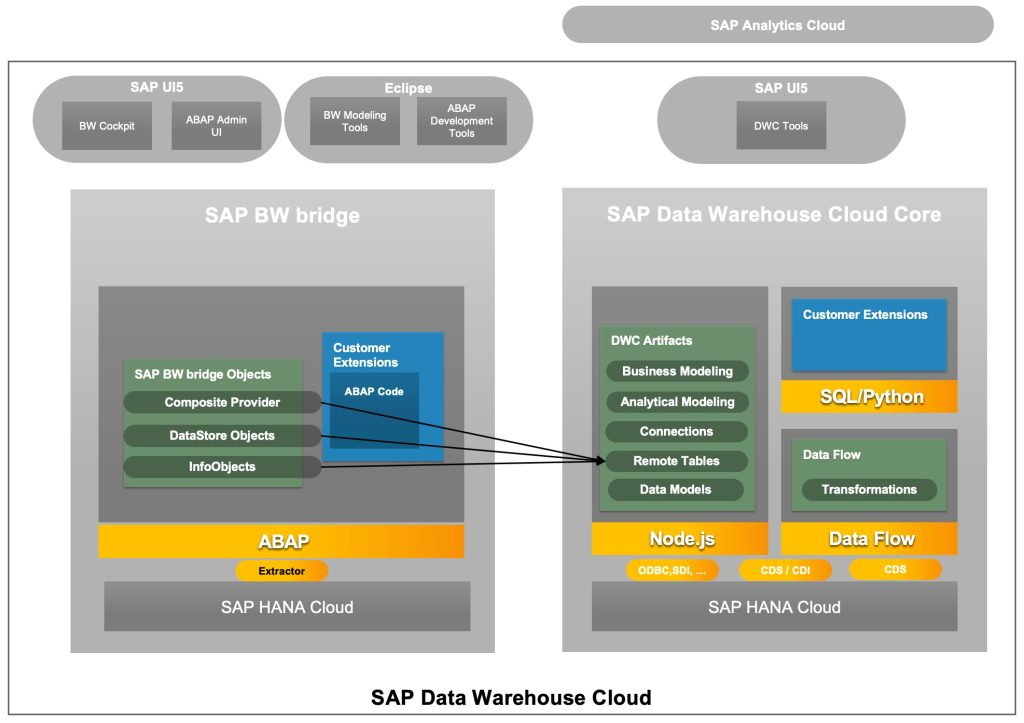
The SAP BW bridge data, and processes are administered, and managed via an SAP UI5 environment called SAP BW bridge Cockpit. The implementation of new objects is done within Eclipse via SAP BW Modeling Tools, and ABAP Development Tools. Within the SAP Data Warehouse Cloud, the SAP BW bridge artefacts are available via remote tables, and can be used via the SAP Data Warehouse Cloud cross-space sharing approach. An SAP GUI is not required to access the SAP BW bridge environment.
SAP BW bridge: Development-Environment
In the following data flow (see figure 6) it can be seen, that the Eclipse environment with SAP BW Modeling Tools, and ABAP Development Tools are used. The well-known SAP flight data model is the foundation for this use case.
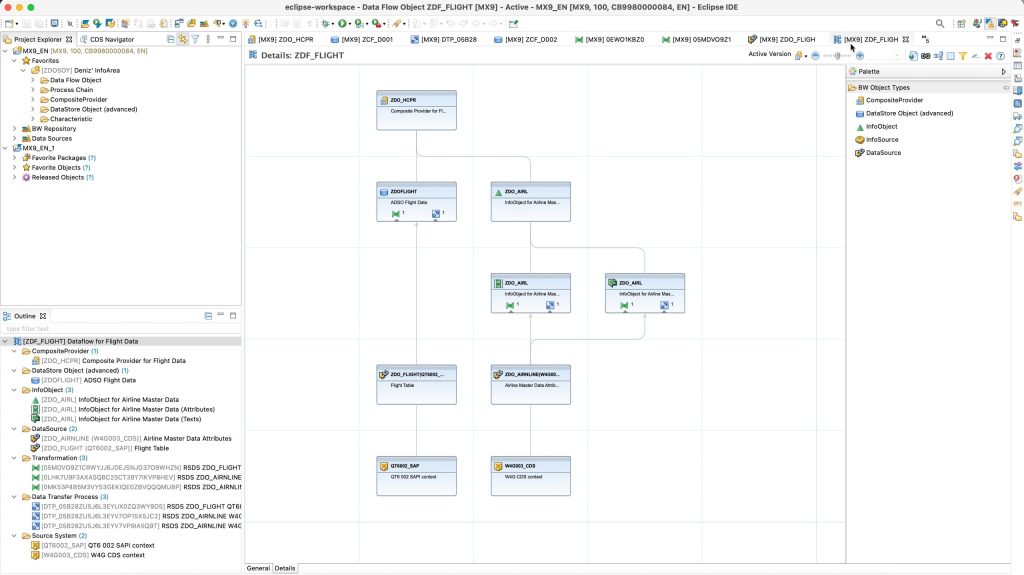
In this scenario, the tables “Flight” for transaction data, and “Airline carrier” for master data are considered. The left branch of the data model handles transaction data, the data is loaded from an SAP ECC system respectively an SAPI Extractor. The right branch of the data model handles master data, the data is loaded from a CDS view. As it can be seen, there is still the subdivision into master data texts, and master data attributes. Within the data flow, transformations, and data transfer processes are used to load data into the advanced DataStore Object, and the master data-bearing InfoObject. Within the Composite Provider, the data is then combined with a join.
The SAP BW bridge component is primarily intended for ODP-based source systems. In this regard, customers have the option to create source systems in the context of ODP. This means that ODP-BW, ODP-HANA, ODP-SAP, ODP-CDS, and ODP-SLT based source systems can be connected. This offers the additional benefits of the Operational Data Provisioning Framework, such as Extract Once Deploy Many, data compression, and more.
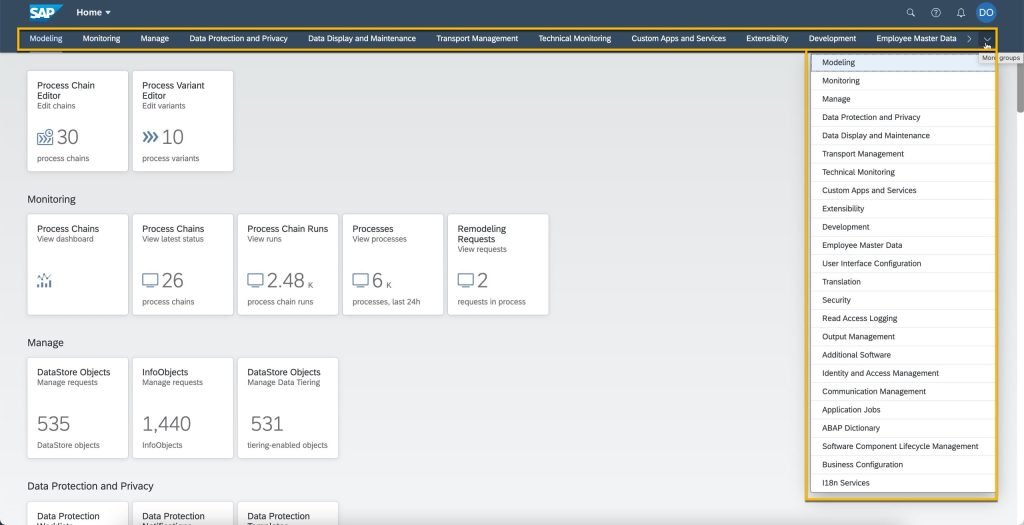
Dedicated process chains are created for both branches in order to load data into the InfoProviders. The process chains are modelled in the SAP UI5 environment for SAP BW bridge called SAP BW bridge Cockpit (see figure 7).
SAP BW bridge Space in SAP Data Warehouse Cloud
If a customer wants to use SAP BW bridge, a provisioning process is triggered by SAP. With that, there will be a dedicated Space for SAP BW bridge in the SAP Data Warehouse Cloud Tenant itself, generated by the provisioning process. This space then has a specific type “SAP BW bridge” (see figure 8).

In the generated SAP BW bridge Space, a connection (see figure 9a) to the SAP BW bridge environment, within the SAP Business Technology Platform, will be generated that contains an SAP HANA Cloud Smart Data Access endpoint, and a HTTP ABAP endpoint. It is possible to connect only one SAP BW bridge System to an SAP Data Warehouse Cloud Tenant.

The SAP HANA Cloud Smart Data Access endpoint is used to connect to the external schema of SAP BW bridge’s SAP HANA Cloud Database that contains the read-only views to the data tables, for moving over the data. The HTTP ABAP endpoint is used to be able to call Monitor UIs via Single Sign on with a named user, and to get Meta Data e.g., for a value help or import of SAP BW bridge Objects (see figure 9b).
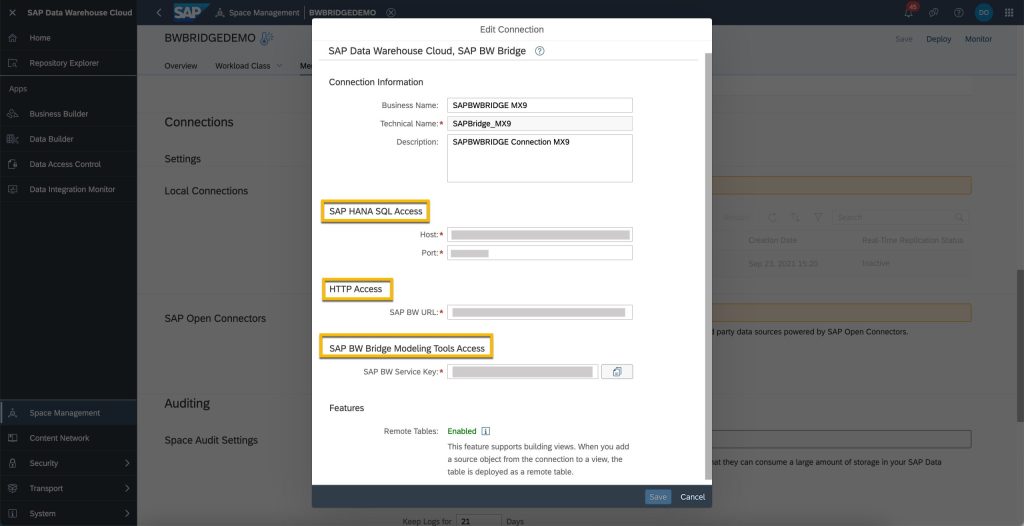
The new connection type cannot be edited by a user in the SAP BW bridge Space, as this connection will be generated by the SAP BW bridge provisioning process automatically. The credentials for the SAP HANA Cloud Smart Data Access connection are provided when the connection is generated. The data tables of the Business Technology Platform environment for SAP BW bridge are exposed as remote tables in the SAP BW bridge Space.
Important: The SAP BW Service Key should be copied, as this needs to be entered when an SAP BW bridge project is set up in Eclipse.

Inside the SAP BW bridge Space, the Create-Button for new connections is disabled, as this Space is restricted to the SAP BW bridge only. The Real-Time Replication Status is inactive for this connection, as it only allows Remote Tables (see figure 9c).
SAP BW bridge Space: Data Builder for importing remote tables
The main purpose of the Data Builder regarding the SAP BW bridge Space (see figure 10) is to import, and share the remote tables for other Spaces, using the Cross-Space Sharing Approach of SAP Data Warehouse Cloud. Unlike the regular Spaces of SAP Data Warehouse Cloud, it is not possible to create Tables, Graphical Views, SQL Views, Entity Relationship Models, or Data Flows within the Data Builder of a SAP BW bridge Space. SAP Data Warehouse Cloud artefacts using the SAP BW bridge remote tables can only be created in other spaces based on the shared remote tables.

Using the Import button in the Data Builder, then via “Import Remote Tables”, the tables of SAP BW bridge InfoProvider can be accessed via the underlying connection (see figure 11).

In the “Import Remote Tables” wizard there is only one connection available, the connection to the SAP BW bridge System (see figure 12). By selecting the defined connection, the connection gets validated. If the validation process is successful, the next step is available.
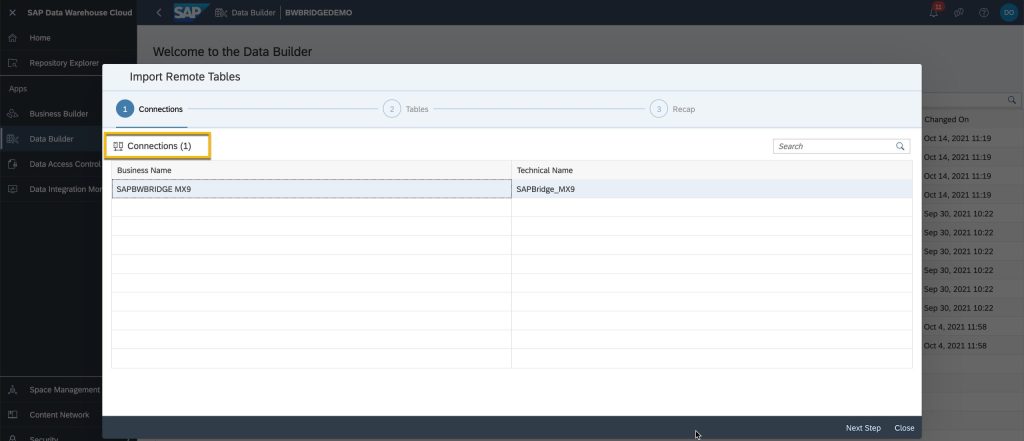
The wizard for the data tables of SAP BW bridge InfoProvider contain the following data tables, which are then available as Remote Tables in SAP BW bridge Space in SAP Data Warehouse Cloud itself.
- Advanced DataStore Object (Reporting View)
- Composite Provider
- Master Data Tables
- Attributes
- Texts
The data tables are displayed by InfoAreas (see figure 13). It is possible to multi select tables to support a mass take over. It is also possible to select an entire InfoArea, then all the tables underneath the objects are selected. Afterwards it is possible to deselect some tables (then the InfoArea can be deselected).
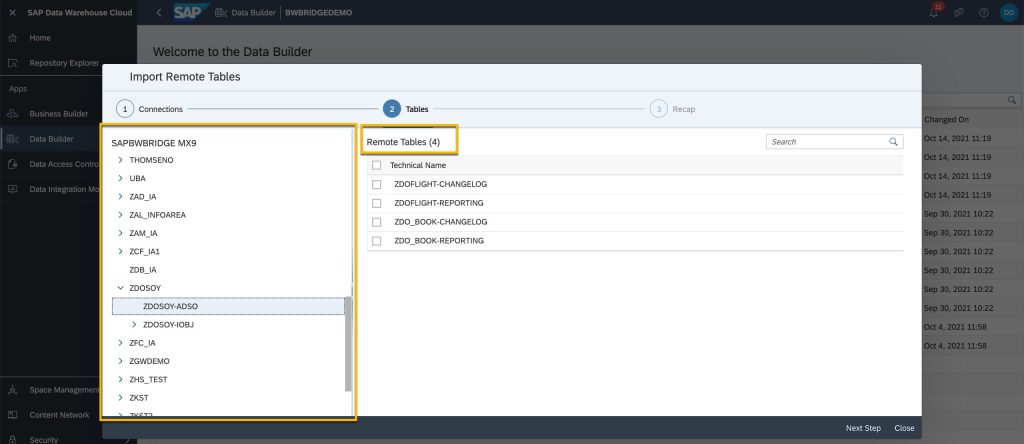
The last step displays the list of objects which are ready for import. There is one more section for Remote Tables, which are already in the repository of SAP Data Warehouse Cloud. The user can also change the technical name, and the business name of the appropriate object. Via “Import and Deploy” the remote tables will be generated with Semantic Usage as Relational Dataset. The Master Data Text tables can be generated as either Dimension or Text (see figure 14).
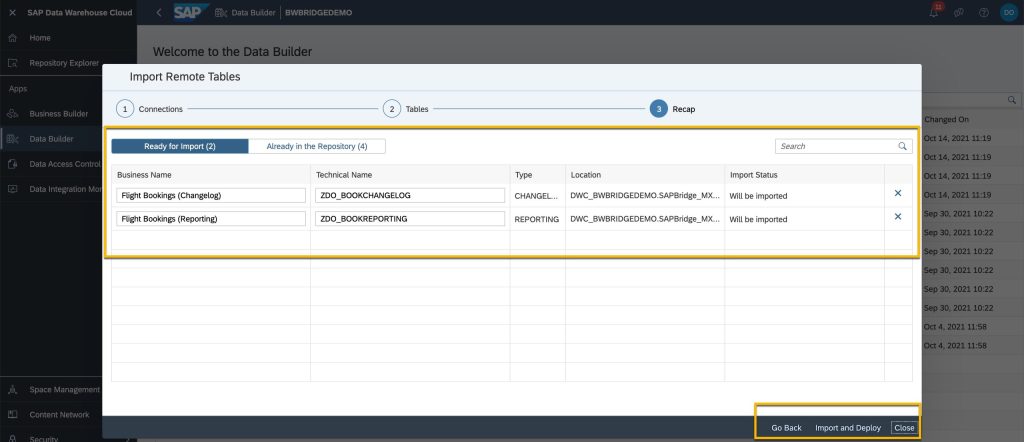
Next, the remote tables located in the SAP BW bridge Space in SAP Data Warehouse Cloud need to be shared with the regular SAP Data Warehouse Spaces. As already outlined before, the main functionality here is to import, and share the remote tables for other spaces. SAP Data Warehouse Cloud artefacts using the remote tables can only be created in other spaces, based on the shared remote tables.
In my example, I have created a standard SAP Data Warehouse Cloud Space “DENIZBWBRIDGE”, which consumes the artefacts, and allows further implementation within the SAP Data Warehouse Cloud (see figure 15).

SAP Data Warehouse Cloud Space: Consuming Shared SAP BW bridge Artefacts
Within standard SAP Data Warehouse Cloud Spaces, the shared SAP BW bridge Remote Tables can be accessed, and other SAP Data Warehouse Cloud functionality can be applied accordingly (see figure 16).
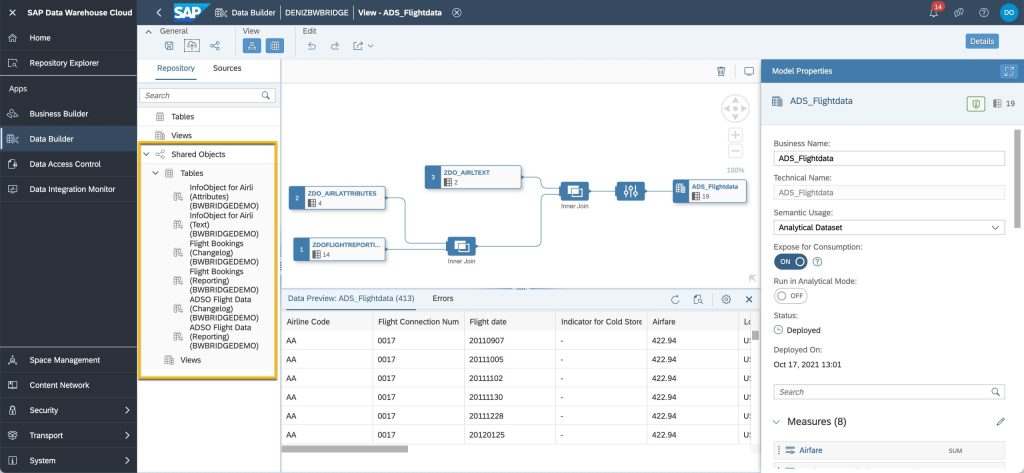
The following SQL code of the previous graphical view (see figure 17) states that the view within the standard SAP Data Warehouse Cloud Space accesses the remote tables of the SAP BW bridge Space in SAP Data Warehouse Cloud.
SELECT *
FROM (("BWBRIDGEDEMO.ZDOFLIGHTREPORTING" AS "ZDOFLIGHTREPORTING"
INNER JOIN "BWBRIDGEDEMO.ZDO_AIRLATTRIBUTES" AS "ZDO_AIRLATTRIBUTES"
ON "ZDOFLIGHTREPORTING"."CARRID" = "ZDO_AIRLATTRIBUTES"."ZDO_AIRL")
INNER JOIN "BWBRIDGEDEMO.ZDO_AIRLTEXT" AS "ZDO_AIRLTEXT"
ON "ZDO_AIRLATTRIBUTES"."ZDO_AIRL" = "ZDO_AIRLTEXT"."ZDO_AIRL");
Figure 17: SQL-Code of Graphical View
SAP Analytics Cloud: Story based on SAP BW bridge data
Finally, based on the analytical data set of SAP Data Warehouse Cloud, which in this case processes SAP BW bridge data, a visualisation of the data can be done via SAP Analytics Cloud (see figure 18) or any other 3rd party front end solution.

Like for other data models in SAP Data Warehouse Cloud you can use SAP Data Warehouse Cloud Live Data Connection of SAP Analytics Cloud. However, SAP Analytics Cloud generally has certain limitations with SAP Data Warehouse Cloud Live Data Connection, detailed information is available in SAP Note 2832606.
SAP BW bridge Space: Data Integration Monitor

Within the SAP BW bridge Space only Remote Tables are available. For the Data Integration Monitor of the SAP BW bridge Space that means, that the View Persistency Monitor, and Data Flow Monitor are not visible (see figure 19).The available functionalities here are the Remote Table Monitor, and Remote Query Monitor. In addition, access to the SAP BW bridge Cockpit is possible via the Data Integration Monitor of the SAP BW bridge Space.
